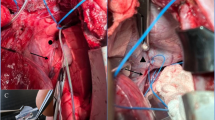Abstract
Introduction
High cervical quadriplegia is associated with high morbidity and mortality. Artificial respiration in these patients carries significant long-term risks such as infection, atelectasis, and respiratory failure. As phrenic nerve pacing has been proven to free many of these patients from ventilatory dependency, we hypothesized that neurotization of the phrenic nerve with the spinal accessory nerve (SAN) may offer one potential alternative to phrenic nerve stimulation via pacing and may be more efficacious and longer lasting without the complications of an implantable device.
Materials and methods
Ten cadavers (20 sides) underwent exposure of the cervical phrenic nerve and the SAN in the posterior cervical triangle. The SAN was split into anterior and posterior halves and the anterior half transposed to the ipsilateral phrenic nerve as it crossed the anterior scalene muscle.
Results
The mean distance between the cervical phrenic nerve and the SAN in the posterior cervical triangle was 2.5 cm proximally, 4 cm at a midpoint, and 6 cm distally. The range for these measurements was 2 to 4 cm, 3.5 to 5 cm, and 4 to 8.5 cm, respectively. The mean excess length of SAN available after transposition to the more anteromedially placed phrenic nerve was 5 cm (range 4 to 6.5 cm). The mean diameter of these regional parts of the spinal accessory and phrenic nerves was 2 and 2.5 mm, respectively. No statistically significant difference was found for measurements between sides.
Conclusions
To our knowledge, using the SAN for neurotization to the phrenic nerve for potential use in patients with spinal cord injury has not been previously explored. Following clinical trials, these data may provide a mechanism for self stimulation of the diaphragm and obviate phrenic nerve pacing in patients with high cervical quadriplegia. Our study found that such a maneuver is technically feasible in the cadaver.



Similar content being viewed by others
References
Alnot JY, Oberlin C (1996) Nerves available for neurotization. In: Alnot JY, Narakas A (eds) Traumatic brachial plexus injuries. Expansion Scientifique Française, Paris, pp 33–38
Baer GA, Talonen PP, Häkkinen V, Exner G, Yrjölä H (1990) Phrenic nerve stimulation in tetraplegia. A new regimen to condition the diaphragm for full-time respiration. Scand J Rehabil Med 22:107–111
Bonnard C, Narakas A (1996) Neurotization using the spinal accessory nerve in the brachial plexus lesions. In: Alnot JY, Narakas A (eds) Traumatic brachial plexus injuries. Expansion Scientifique Française, Paris, pp 156–166
Carlstedt T, Anand P, Htut M, Misra P, Svensson M (2004) Restoration of hand function and so called “breathing arm” after intraspinal repair of C5-T1 brachial plexus avulsion injury. Neurosurg Focus 16:1–5
Dailiana ZH, Mehdian H, Gilbert A (2001) Surgical anatomy of spinal accessory nerve: is trapezius functional deficit inevitable after division of the nerve? J Hand Surg 26:137–141
DiMarco AF (2005) Restoration of respiratory muscle function following spinal cord injury. Review of electrical and magnetic stimulation techniques. Respir Physiol Neurobiol 147:273–287
Garrido H, Mazaira J, Gutierrez P, Gonzalez E, Rivas J, Madrazo J (1987) Continuous respiratory support in quadriplegic children by bilateral phrenic nerve stimulation. Thorax 42:573–577
Glenn WWL, Hogan KF, Loke JSO, Ciesielski TE, Phelps ML, Rowedder R (1984) Ventilatory support by pacing of the conditioned diaphragm in quadriplegia. N Engl J Med 310:1150–1155
Glenn WW, Gee JB, Schachter EN (1978) Diaphragm pacing. Application to a patient with chronic obstructive pulmonary disease. J Thorac Cardiovasc Surg 75:273–281
Kierner AC, Zelenka I, Heler S, Burian M (2000) Surgical anatomy of the spinal accessory nerve and the trapezius branches of the cervical plexus. Arch Surg 135:1428–1431
Kim DH, Cho YJ, Tiel RL, Kline DG (2003) Surgical outcomes of 111 spinal accessory nerve injuries. Neurosurgery 53:1106–1113
Krieger AJ, Krieger AJ (2000) The intercostal to phrenic nerve transfer: an effective means of reanimating the diaphragm in patients with high cervical spine injury. Plast Reconstr Surg 105:1255–1261
Krieger AJ, Danetz I, Wu SZ, Spatola M, Sapru HN (1983) Electrophrenic respiration following anastomosis of phrenic with branchial nerve in the cat. J Neurosurg 59:262–267
Laroche CM, Mier AK, Spiro SG, Newsom-Davis J, Moxham J, Green M (1989) Respiratory muscle weakness in the Lambert–Eaton myasthenic syndrome. Thorax 44:913–918
Lu L, Haman SP, Ebraheim NA (2002) Vulnerability of the spinal accessory nerve in the posterior triangle of the neck: a cadaveric study. Orthoped 25:71–74
Midha R (2004) Nerve transfers for severe brachial plexus injuries: a review. Neurosurg Focus 16:1–10
Miller JI, Farmer JA, Stuart W, Apple D (1990) Phrenic nerve pacing of the quadriplegic patient. J Thorac Cardiovasc Surg 99:35–39
Nishino T, Yonezawa T, Honda Y (1983) Properties of spinal accessory nerve activity responses to changes in chemical drive. J Appl Physiol 55:164–168
Nochomovitz ML, Hokins M, Brodkey J, Montenegro H, Mortimer JT, Cherniack NS (1984) Conditioning of the diaphragm with phrenic nerve stimulation after prolonged disuse. Am Rev Respir Dis 130:685–688
Ordronneau J, Despins P, Keravel Y, Cahilleux E, Guiheneuc P, Chollet S (1989) Phrenic stimulation in C1–C2 tetraplegia. Apropos of a case. Rev Mal Respir 6:469–471
Pamphlett R, Murray N, Louda C (1996) Phrenic nerve maturation in the sudden infant death syndrome. Acta Neuropathol 91:422–426
Satomi H, Takahashi K, Aoki M, Kasaba T, Kurosawa Y, Otsuka K (1985) Localization of the spinal accessory motoneurons in the cervical cord in connection with the phrenic nucleus: an HRP study in cats. Brain Res 344:227–230
Treves F (1907) Surgical applied anatomy, 5th edn. Lea Brothers, Philadelphia
Tubbs RS, Salter EG, Oakes WJ (2005) Anatomical landmarks for nerves of the neck: a vade mecum for neurosurgeons. Neurosurgery 56:256–260
Tubbs RS (2005) Landmarks for spinal accessory nerve in posterior cervical triangle. J Neurosurgery Spine 3:375–378
Zifko UA, Nicolle MW, Grisold W, Bolton CF (1999) Repetitive phrenic nerve stimulation in myasthenia gravis. Neurology 53:1083–1087
Author information
Authors and Affiliations
Corresponding author
Rights and permissions
About this article
Cite this article
Tubbs, R.S., Pearson, B., Loukas, M. et al. Phrenic nerve neurotization utilizing the spinal accessory nerve: technical note with potential application in patients with high cervical quadriplegia. Childs Nerv Syst 24, 1341–1344 (2008). https://doi.org/10.1007/s00381-008-0650-4
Received:
Published:
Issue Date:
DOI: https://doi.org/10.1007/s00381-008-0650-4




